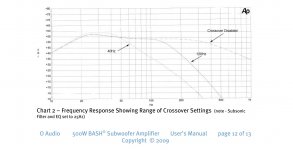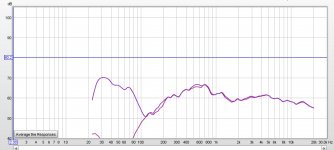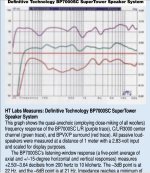So my BP7000SC Definitive Technology have great lower bass, but the mid bass is a bit of a black hole between 70Hz and 150Hz.
I was thinking about getting a HSU MBM but also interested in maybe trying to build something myself. The HSU MBM I would run sealed, but it's down firing, so I'm not sure if that would be good or bad since I need to fill in between 60HZ and 150HZ.
I also don't want any additional to be too large in size, but understand that they need to be big enough to keep up with the BP7000SC towers.
Thoughts? Should I go with a HSU MBM? Build myself? If so what driver, enclosure type, and amp? I do have a Minidsp I'm not currently using and my preamp is a Denon 2808 with Audyssey XT
I was thinking about getting a HSU MBM but also interested in maybe trying to build something myself. The HSU MBM I would run sealed, but it's down firing, so I'm not sure if that would be good or bad since I need to fill in between 60HZ and 150HZ.
I also don't want any additional to be too large in size, but understand that they need to be big enough to keep up with the BP7000SC towers.
Thoughts? Should I go with a HSU MBM? Build myself? If so what driver, enclosure type, and amp? I do have a Minidsp I'm not currently using and my preamp is a Denon 2808 with Audyssey XT
A "black hole between 70Hz and 150Hz" sounds more like a room mode problem than a speaker problem, adding more power in to a room mode "black hole" won't solve it.
Have you experimented with different speaker positions or listened in various locations to determine the response hole is universal?
Have you experimented with different speaker positions or listened in various locations to determine the response hole is universal?
http://www.definitivetech.com/downloads/BP7000SC_7001SC_Manual12109_read.pdf
Are they new speakers, that could have some influence in the quality.
Looking at the summation at crossover range from the woofer and mids and after you check for the best position, maybe there's an issue with the sub crossover.
Others like this type of Bash 500 Plate Amps have EQ settings at crossover from 50-150Hz to the woofer/sub and some have also by-pass switch. A wrong setting at 40-50Hz could be a problem.
Are they new speakers, that could have some influence in the quality.
Looking at the summation at crossover range from the woofer and mids and after you check for the best position, maybe there's an issue with the sub crossover.
Others like this type of Bash 500 Plate Amps have EQ settings at crossover from 50-150Hz to the woofer/sub and some have also by-pass switch. A wrong setting at 40-50Hz could be a problem.
Attachments
Assuming room modes (or lack of phase alignment) are not responsible for the response dip, it appears the system was designed for a low frequency "haystack" response, the lack of response at the acoustic crossover would fill in when the LF is brought up, but result in a huge bass hump.I uploaded a frequency response. Red is just the mids and highs. Purple is with the bass drivers turned up 1/4 of the way.
Humped up LF response is popular with many people, kind of a built in "loudness contour". Room response and placement can also increase LF response greatly, requiring quite a bit of EQ to make for flat response if one can't move the cabinets to compensate.
If the low pass filter of the LF drivers was raised to match the acoustical roll off of the mid drivers, response could be smoothed out without resulting in the bass hump.
Last edited:
I was thinking about this speaker after I posted and maybe if you placed the speakers straight (like the bass pointing at you/sweet spot) this is, place them in the usual space on the sides but facing the room straight, not toe in, in a manner that the bass/sub will be in view of the sofa so to speak. This would make you get more of the upper LF in your spot. Another would be to try to have more reflection from the side walls. That is a difficult set-up or there is something wrong with those speakers. If they are new, you can ask someone to have them checked for the right (DSP) equalization or at least if that's the set-up with all the speakers/model, maybe everybody else is having the same problem. 
note: if you describe your speakers would be better, do they have one sub/woofer on each side totaling 4 drivers or just 1 per speaker.

note: if you describe your speakers would be better, do they have one sub/woofer on each side totaling 4 drivers or just 1 per speaker.
Assuming room modes (or lack of phase alignment) are not responsible for the response dip, it appears the system was designed for a low frequency "haystack" response, the lack of response at the acoustic crossover would fill in when the LF is brought up, but result in a huge bass hump.
Humped up LF response is popular with many people, kind of a built in "loudness contour". Room response and placement can also increase LF response greatly, requiring quite a bit of EQ to make for flat response if one can't move the cabinets to compensate.
If the low pass filter of the LF drivers was raised to match the acoustical roll off of the mid drivers, response could be smoothed out without resulting in the bass hump.
I think the biggest hump is caused my the bass radiators. I think they are tuned very low. Appears to be a very high quality radiators though. I really don't have any way to control the slope of the woofer roll off (seems very steep!). It's all DSP controlled.
I was thinking about this speaker after I posted and maybe if you placed the speakers straight (like the bass pointing at you/sweet spot) this is, place them in the usual space on the sides but facing the room straight, not toe in, in a manner that the bass/sub will be in view of the sofa so to speak. This would make you get more of the upper LF in your spot. Another would be to try to have more reflection from the side walls. That is a difficult set-up or there is something wrong with those speakers. If they are new, you can ask someone to have them checked for the right (DSP) equalization or at least if that's the set-up with all the speakers/model, maybe everybody else is having the same problem.
note: if you describe your speakers would be better, do they have one sub/woofer on each side totaling 4 drivers or just 1 per speaker.
These are bipolar speakers.
Two mids in the back and a tweeter. I think I was told the mids are crossover higher then the fronts (around 250hz).
Two mids and a tweeter in the front. I was told the front are crossover at 80Hz, but I don't believe it.
One side has a active DSP controlled woofer and a radiator. The other side has a radiator. I have the active woofers facing in on both sides. With the woofer facing the wall, it doesn't sound as tight.
Measurement were taken with only one speaker connected, so the response is from just a single tower in it's typical position. I've measured these several times in different positions, and the response seems very consistent. Audyssey helps bring a little more lower mids, but also tends to have some issues with the woofers.
That would be consistent with your pic on post#6.I think I was told the mids are crossover higher then the fronts (around 250hz).
Two mids and a tweeter in the front. I was told the front are crossover at 80Hz, but I don't believe it.
The back radiating to front and vice-versa.
If the crossover of the mids were well set then you wouldn't have that dip in measurement.

What's missing (in the dip) is the mids set for 80Hz, they are DSP'ed to 250Hz...
http://www.diyaudio.com/forums/atta...-mbm-else-build-myself-more-midbass-chart.jpg
Never mind. It looks like they run out of the right type of crossovers (in the last minute... and mistakes happen).The mids are not DSP'ed. The mids and tweeters are on passive crossovers.
I uploaded a frequency response. Red is just the mids and highs. Purple is with the bass drivers turned up 1/4 of the way.
Hmm, yours is shifted upwards, but apparently a huge dip is designed in: Bipolar SuperTower BP7000SC Manuals - Page 2
GM
Yeah, from what I see they are defective from the factory (PI - pun intended).
~4dB attenuation (factory standard/not yours) in a must have frequency at the crossover range summation frequency, when they should overlap with the same phase.
Each client should have a technician adjusting and calibrating each speaker at home. The problem of to much tech.
Definitive NOT VERY GOOD !!!
~4dB attenuation (factory standard/not yours) in a must have frequency at the crossover range summation frequency, when they should overlap with the same phase.
Each client should have a technician adjusting and calibrating each speaker at home. The problem of to much tech.
Definitive NOT VERY GOOD !!!
Attachments
I pulled the speakers 4 feet into the room and about 4 feet from the side walls. The bass toned down a lot (possible null?), but the midbass didn't really pickup. It did sound more neutral. I had to check the settings serveral times to ensure the woofers were working lol I didn't take any measurements and just moved them back.
My next question is, if get a midbass module, should I delay it to the woofers in the towers (they are dsp controlled so there is a processing delay) or just match it up to the mids and tweeters? I would think mids and tweeters..?
My next question is, if get a midbass module, should I delay it to the woofers in the towers (they are dsp controlled so there is a processing delay) or just match it up to the mids and tweeters? I would think mids and tweeters..?
Just to the first question.I pulled the speakers 4 feet into the room and about 4 feet from the side walls. The bass toned down a lot (possible null?), but the midbass didn't really pickup. It did sound more neutral. I had to check the settings serveral times to ensure the woofers were working lol I didn't take any measurements and just moved them back.
(I'm not sure about the second, I don't know or do not understand.)
Yes, it looks better, I assume and I would expect, but, still representative of the 5 dB attenuation at 100 Hz or more set from the factory. This parameter should (should) be accessed at each clients home by the distributor or manufacturers representative. Don't ask me why or how, but that's the technology problem, theirs not mine. They have DSP and if bad adjust it for each case or room size.
Now, it makes me think (maybe it's not the case and they are really bad, NPI) that (first) you have the speakers turn back, with the front baffle facing the back wall.
Of course this isn't the case, because when you look at the woofers you see the plate in the back, so they should be in the correct position. But, (second) it's possible also that someone(?) by mistake, used the wrong crossovers in the front, the ones that where for the back drivers. I already mentioned the fact before in this thread, but without someone, the manufacturer or you rechecking that possibility, everything will stays the same...
- Status
- This old topic is closed. If you want to reopen this topic, contact a moderator using the "Report Post" button.
- Home
- Loudspeakers
- Subwoofers
- HSU MBM else build myself for more midbass


